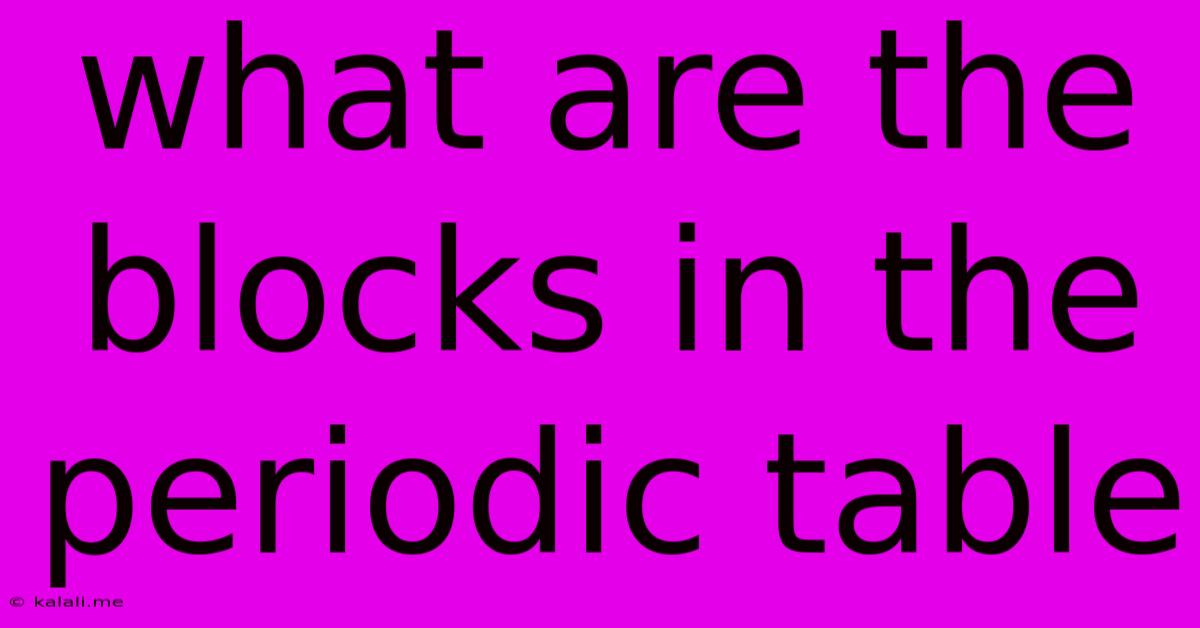What Are The Blocks In The Periodic Table
Kalali
Jun 13, 2025 · 3 min read

Table of Contents
What are the Blocks in the Periodic Table? Understanding s, p, d, and f Blocks
The periodic table, a cornerstone of chemistry, organizes elements based on their atomic structure and properties. While you might be familiar with rows (periods) and columns (groups), understanding the blocks is crucial for comprehending the underlying electron configurations and predicting element behavior. This article dives into the four blocks: s, p, d, and f, explaining their characteristics and the elements they contain.
Understanding Electron Configuration and Blocks
The arrangement of electrons within an atom's electron shells dictates its chemical properties. Elements are grouped into blocks based on the type of atomic orbital that receives the outermost or "valence" electron. This outermost electron determines the element's reactivity and bonding characteristics. The periodic table's structure visually represents this electron configuration.
The s-Block Elements
The s-block occupies the two leftmost columns of the periodic table. These elements fill their outermost s atomic orbitals. The s-orbital can hold a maximum of two electrons. This block comprises:
- Alkali Metals (Group 1): Highly reactive metals characterized by a single valence electron. Examples include lithium (Li), sodium (Na), and potassium (K).
- Alkaline Earth Metals (Group 2): Also reactive metals, but less so than alkali metals. They have two valence electrons. Examples include beryllium (Be), magnesium (Mg), and calcium (Ca).
- Hydrogen and Helium: While sometimes placed separately, hydrogen and helium are included in the s-block due to their electron configurations. Hydrogen's single electron occupies the 1s orbital, while helium's two electrons fill the 1s orbital completely.
The p-Block Elements
The p-block elements occupy the six columns on the right-hand side of the periodic table. These elements fill their outermost p atomic orbitals. Each p-subshell can hold up to six electrons, hence the six columns. This diverse block includes:
- Nonmetals: Many familiar nonmetals such as oxygen (O), nitrogen (N), chlorine (Cl), and the noble gases (Group 18) like helium (He), neon (Ne), and argon (Ar).
- Metalloids (Semi-metals): Elements exhibiting properties of both metals and nonmetals, like boron (B), silicon (Si), and arsenic (As).
- Post-transition Metals: Metals like aluminum (Al), tin (Sn), and lead (Pb), that fall between the transition metals and nonmetals.
The d-Block Elements
The d-block encompasses the transition metals located in the central part of the periodic table. These elements are characterized by filling their d atomic orbitals. Each d-subshell can hold a maximum of ten electrons. Key characteristics of d-block elements include:
- Variable Oxidation States: Ability to exist in multiple oxidation states, leading to a wide range of compounds.
- Formation of Colored Compounds: Many transition metal compounds exhibit vibrant colors due to the electronic transitions within their d-orbitals.
- Catalytic Activity: Many transition metals and their compounds act as catalysts in various chemical reactions.
- Examples: Iron (Fe), copper (Cu), gold (Au), zinc (Zn), and many others.
The f-Block Elements
The f-block elements, also known as inner transition metals, are found at the bottom of the periodic table, separated into two rows: the lanthanides and actinides. They fill their f atomic orbitals. Each f-subshell can hold up to fourteen electrons.
- Lanthanides: The elements from cerium (Ce) to lutetium (Lu), known for their similar chemical properties.
- Actinides: The elements from thorium (Th) to lawrencium (Lr), many of which are radioactive. Uranium (U), plutonium (Pu) are notable examples.
Conclusion:
Understanding the s, p, d, and f blocks is vital for grasping the organization and predictive power of the periodic table. By recognizing the electron configurations and associated orbital filling patterns, we can better understand the periodic trends in properties and the chemical behavior of different elements. This knowledge forms the foundation for many advanced concepts in chemistry.
Latest Posts
Latest Posts
-
Which Of The Following Is Not A Transition Metal
Jun 14, 2025
-
Which Of The Following Is True About Tsunamis
Jun 14, 2025
-
The Boiling Point Of A Given Liquid Varies
Jun 14, 2025
-
What Is The Lcm Of 25 And 35
Jun 14, 2025
-
What Is The Factor Of 200
Jun 14, 2025
Related Post
Thank you for visiting our website which covers about What Are The Blocks In The Periodic Table . We hope the information provided has been useful to you. Feel free to contact us if you have any questions or need further assistance. See you next time and don't miss to bookmark.